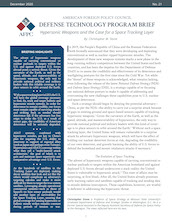In 2019, the People’s Republic of China and the Russian Federation both formally announced that they were developing and deploying conventional as well as nuclear-tipped hypersonic missiles. The development of these new weapons systems marks a new phase in the long-running military competition between the United States and both countries, and has been the impetus for the Department of Defense (DoD) to re-assess the credibility and effectiveness of its deterrence and warfighting postures for the first time since the Cold War. Yet while the “threat” of these weapons is acknowledged, what remains lacking, even following the release of the latest National Defense Strategy (NDS) and Defense Space Strategy (DSS), is a strategy capable of re-focusing our national defense posture to make it capable of addressing and overcoming the new challenges these capabilities pose to U.S. nuclear and space deterrence.
Such a strategy should begin by denying the potential adversary—China, as per the NDS—the ability to carry out a surprise attack because of gaps in existing ground and space-based sensors capable of tracking hypersonic weapons. Given the curvature of the Earth, as well as the speed, altitude, and maneuverability of hypersonics, the only way to provide national political and military leaders with this kind of coverage is to place sensors in orbit around the Earth. Without such a space tracking layer, the United States will remain vulnerable to a surprise attack by adversary hypersonic weapons, which will have the effect of holding our nuclear deterrent forces at risk, degrading the credibility of our own deterrent, and gravely harming the ability of U.S. forces to defend the homeland and mount retaliatory attacks if necessary...
